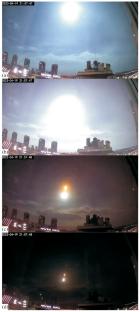基辅流星体的物理效应:第1部分
摘要
本研究旨在全面分析和估计基辅流星体进入陆地大气层并在基辅州(乌克兰)Bila Tserkva raion上空爆炸的气体动力学影响以及机械和光学影响。根据国际流星组织(IMO)的数据,该流星体的视星等为-18等。根据我们的估计,发光功率为215GW,有效持续时间为2.4±0.2s,总发光能量为25.2±2.5GJ,TNT的初始动能为0.09±0.01kt或375±35GJ。宇宙体的初始质量估计为0.89±0.09吨,体积为0.250±0.025立方米,大小为79±3厘米。流星体的初始速度达到29公里/秒。倾角,即轨迹与水平面形成的角度,为32°。爆炸高度等于38km,倾角等于32°,估计材料密度为3.5t/m3,接近岩石密度。分析了这些过程的能量、气体动力学效应以及来自天体的机械和光学效应。在大约2.5兆帕的动压下进行碎片整理的天体碎片减速的主要能量释放发生在大约38公里的高度、长度为2公里的区域。建议进行准连续碎片整理,以产生遵循幂律的质量分布。对弹道和爆炸冲击波的主要参数进行了估算。在马赫数为97的情况下,弹道冲击波的半径估计约为77米,基本周期为0.7秒,随着传播路径长度从50公里增加到5000公里,其色散从3.7秒增加到11.5秒。圆柱形和球形波前冲击波的直径分别约为0.28和0.34公里,它们的基本周期分别约为2.6和3.2秒。随着传播路径长度从50公里增加到5000公里,这些周期从9.5秒增加到30.0秒,从11.1秒增加到35.1秒。在流星体爆炸高度附近,相对超压最大。它随着海拔的降低而降低,随着海拔的增加而增加,直到大约120–150公里,达到大约6–7%的值,然后进一步降低到几个百分点。超压的绝对值估计在爆炸高度附近;随后,它随着海拔的下降而下降到20-25公里,然后又进一步增加。据估计,在爆炸中心,圆柱形波阵面的压力约为94Pa,球形波阵面的压力约为99Pa,这不足以损坏地面上的物体。随着海拔从8–15 Pa增加到几个微米级,超压降低。假设有效闪光的平均持续时间估计为2.4秒,火球的最大功率估计为21吉瓦,火球附近的功率通量(或更准确地说,锥体长0.5公里,直径2.4米)估计为5.1兆瓦/平方米。同时,温度估计约为3100 K,Wien波长估计为9.4×10–7 m。

This study is aimed at comprehensively analyzing and estimating the effects in gas dynamics, as well as mechanical and optical effects, from the Kyiv meteoroid that entered the terrestrial atmosphere and exploded over Bila Tserkva raion, Kyiv oblast (Ukraine). According to the International Meteor Organization (IMO), the apparent magnitude of the meteoroid was –18. According to our estimates, the luminous power was 215 GW with an effective duration of 2.4 ± 0.2 s, the total luminous energy was 25.2 ± 2.5 GJ, and the initial kinetic energy was 0.09 ± 0.01 kt of TNT or 375 ± 35 GJ. The initial mass of the cosmic body was estimated to be 0.89 ± 0.09 t, the volume was 0.250 ± 0.025 m3, and the size was 79 ± 3 cm. The initial velocity of the meteoroid reached 29 km/s. The inclination angle, i.e., the angle that the trajectory makes with the horizontal plane, was 32°. The explosion altitude equal to 38 km and the inclination angle equal to 32° give an estimate of 3.5 t/m3 for the material density, which is close to the rock density. The energy of the processes, the gas dynamics effects, and the mechanical and optical effects from the celestial body have been analyzed. The main release of energy associated with the deceleration of the fragments of the celestial body, which was defragmented under a dynamical pressure of approximately 2.5 MPa, took place in the region with a length of 2 km at an altitude of approximately 38 km. A quasi-continuous defragmentation is suggested to produce a mass distribution that follows a power law. The main parameters of the ballistic and explosive shock waves have been estimated. For the Mach number of 97, the radius of the ballistic shock wave is estimated to be approximately 77 m, and the fundamental period to be 0.7 s, which showed a dispersive increase from 3.7 to 11.5 s with the propagation path length increasing from 50 to 5000 km. The radii of cylindrical and spherical wavefront shock waves were approximately 0.28 and 0.34 km, and their fundamental periods were approximately 2.6 and 3.2 s, respectively. These periods increased from 9.5 to 30.0 s and from 11.1 to 35.1 s with an increase in the propagation path length from 50 to 5000 km. In the vicinity of the meteoroid’s explosion height, the relative excess pressure was a maximum. It decreased with a decrease in the altitude and increased with an increase in the altitude up to approximately 120–150 km, at which it attained values of approximately 6–7% and then further decreased down to a few percent. The absolute value of the excess pressure is estimated to be near the altitude of the explosion; subsequently it decreased with a decrease in the altitude down to 20–25 km and then increased further again. At the epicenter of the explosion, it is estimated to be approximately 94 Pa for the cylindrical wavefront and approximately 99 Pa for the spherical wavefront, which is not enough to damage objects on the ground. The excess pressure decreased with an increase in the altitude from 8–15 Pa to a few micropascals. Given an estimate of 2.4 s for the average duration of the effective light flash, the maximum power of the fireball is estimated to be 21 GW, and the power flux near the fireball (or more precisely, the cone 0.5 km in length and 2.4 m in diameter), is estimated to be 5.1 MW/m2. At the same time, the temperature is estimated to be approximately 3100 K, and the Wien wavelength is estimated to be 9.4 × 10–7 m.

 求助内容:
求助内容: 应助结果提醒方式:
应助结果提醒方式:


